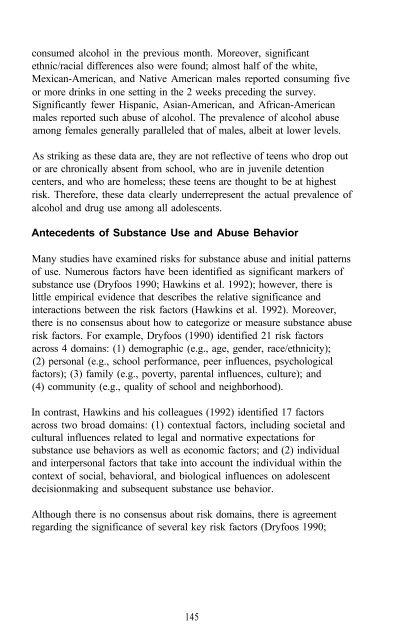The Context of HIV Risk Among Drug Users and Their Sexual Partners
The Context of HIV Risk Among Drug Users and Their Sexual Partners
The Context of HIV Risk Among Drug Users and Their Sexual Partners
Create successful ePaper yourself
Turn your PDF publications into a flip-book with our unique Google optimized e-Paper software.
consumed alcohol in the previous month. Moreover, significant<br />
ethnic/racial differences also were found; almost half <strong>of</strong> the white,<br />
Mexican-American, <strong>and</strong> Native American males reported consuming five<br />
or more drinks in one setting in the 2 weeks preceding the survey.<br />
Significantly fewer Hispanic, Asian-American, <strong>and</strong> African-American<br />
males reported such abuse <strong>of</strong> alcohol. <strong>The</strong> prevalence <strong>of</strong> alcohol abuse<br />
among females generally paralleled that <strong>of</strong> males, albeit at lower levels.<br />
As striking as these data are, they are not reflective <strong>of</strong> teens who drop out<br />
or are chronically absent from school, who are in juvenile detention<br />
centers, <strong>and</strong> who are homeless; these teens are thought to be at highest<br />
risk. <strong>The</strong>refore, these data clearly underrepresent the actual prevalence <strong>of</strong><br />
alcohol <strong>and</strong> drug use among all adolescents.<br />
Antecedents <strong>of</strong> Substance Use <strong>and</strong> Abuse Behavior<br />
Many studies have examined risks for substance abuse <strong>and</strong> initial patterns<br />
<strong>of</strong> use. Numerous factors have been identified as significant markers <strong>of</strong><br />
substance use (Dryfoos 1990; Hawkins et al. 1992); however, there is<br />
little empirical evidence that describes the relative significance <strong>and</strong><br />
interactions between the risk factors (Hawkins et al. 1992). Moreover,<br />
there is no consensus about how to categorize or measure substance abuse<br />
risk factors. For example, Dryfoos (1990) identified 21 risk factors<br />
across 4 domains: (1) demographic (e.g., age, gender, race/ethnicity);<br />
(2) personal (e.g., school performance, peer influences, psychological<br />
factors); (3) family (e.g., poverty, parental influences, culture); <strong>and</strong><br />
(4) community (e.g., quality <strong>of</strong> school <strong>and</strong> neighborhood).<br />
In contrast, Hawkins <strong>and</strong> his colleagues (1992) identified 17 factors<br />
across two broad domains: (1) contextual factors, including societal <strong>and</strong><br />
cultural influences related to legal <strong>and</strong> normative expectations for<br />
substance use behaviors as well as economic factors; <strong>and</strong> (2) individual<br />
<strong>and</strong> interpersonal factors that take into account the individual within the<br />
context <strong>of</strong> social, behavioral, <strong>and</strong> biological influences on adolescent<br />
decisionmaking <strong>and</strong> subsequent substance use behavior.<br />
Although there is no consensus about risk domains, there is agreement<br />
regarding the significance <strong>of</strong> several key risk factors (Dryfoos 1990;<br />
145
















